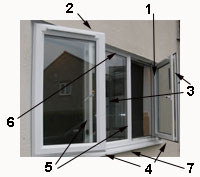9 Stages for Painting a Casement Window Correctly
Working in a logical order will help you get a professional paint job when painting casement windows.
If you have Upvc windows you won’t need to paint them, but timber windows need painting periodically to protect them from the elements.
This guide assumes you know about preparing woodwork for painting, but there are lots of helpful guides in our main project section if you need further assistance.

Step by Step Guide to Painting a Timber Casement Window
This sequence of painting applies for each coat of paint that you apply, and don’t forget to sand and clean down between each layer of paint.
- Remove all the window furniture. Make sure that whatever you use to stand on to reach the higher parts of the window is safe and secure (see our project on using ladders safely)
- Pick a good quality brush about 12 to 25mm (½ – 1 inch). See our types of paint brush project for guidance. Don’t load too much paint onto the brush so you say in control of the paint
- Even a large window will not use a lot of paint so tip some of your paint into a small paint kettle with a handle which will make it so much easier to handle
- Always paint opening sections of any window first: Open all the windows and find a way to secure the open casements in position. This is quite easily done by tacking a small piece of timber to the underside of the opening sash and the other end to the underside of the sill or cill
- First Paint the rails and stiles of the opening windows in the order shown on the numbered diagram above (1-4)
- Paint the areas next to the glass first
- Next paint the opposite side,
- Finally paint the face that shows when the window is closed.
- Paint any glazing bars by painting the left side of every vertical bar, then the right side of every vertical bar (If you are right handed work left to right – if you are left handed paint the left side first followed by the right)
- Work top to bottom on any horizonal glazing bars
- Next paint the window frame, using the same order as listed above
- Paint the cross bars
- Paint the upright bars
- Finally paint the outer frame and sill
- Allow the paint to dry for at least as long as the paint manufacturer recommends before closing the windows, to avoid the windows sticking and damaging the paint.
When calculating drying times you should take note of any allowance for the conditions you are painting in.
If you have created any paint splashes or wobbly lines, you can use a window scraper like the one below, to clean off any unwanted paint from the glass. See our painting sash windows project for instructions on how to do this effectively and neatly.

This simple step-by-step guide helps you get the best results by painting in a logical order if you are already confident about the process of painting woodwork, but if you are not sure about the hows and whys of painting casement windows then check out the full project on How to Paint a Casement Window here for further guidance on how often to paint your windows and whether to use primer and undercoat.





